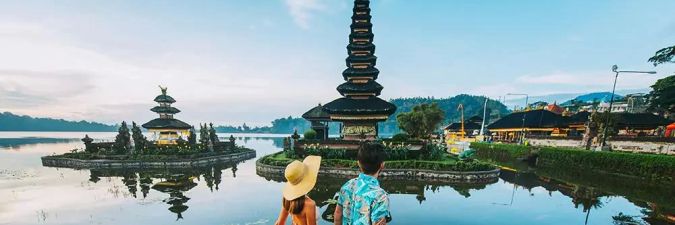Traditional Indonesian Attire and Crafts: A Cultural Journey Through the Archipelago
- 1. Overview of Traditional Indonesian Attire and Crafts
- 2. Batik: The Iconic Indonesian Textile
- 3. Sarong: The Versatile Traditional Garment
- 4. Woven Crafts: Traditional Indonesian Handicrafts
- 5. Exploring Indonesian Culture Through Attire and Crafts
- 6. Book Your Cultural Exploration with Elalephcruising
1. Overview of Traditional Indonesian Attire and Crafts
Indonesia is a land of rich cultural diversity, and its traditional attire and crafts reflect the many ethnic groups and customs that have shaped its identity. From intricate textiles to vibrant jewelry, Indonesian crafts and clothing are a testament to the country's artistic heritage. Travelers who wish to immerse themselves in the local culture can explore traditional attire, crafts, and the stories behind these art forms.
In this guide, we'll take a closer look at some of the most iconic traditional Indonesian attire and crafts, from the renowned batik fabrics to the unique handwoven baskets. These elements of Indonesian culture offer an authentic glimpse into the country's history and artistic expressions.
2. Batik: The Iconic Indonesian Textile
Batik is perhaps the most famous traditional textile of Indonesia. This intricate art form involves using wax and dye to create detailed patterns on fabric. The technique dates back centuries and is deeply rooted in Indonesian culture, with each region having its own distinctive batik patterns and meanings.
2.1 The Process of Making Batik
The process of creating batik involves applying molten wax to fabric in specific patterns. Once the wax is applied, the fabric is dyed in vibrant colors. The wax acts as a barrier, preventing the dye from penetrating certain areas, creating intricate designs. After the dyeing process, the wax is removed, revealing the detailed patterns.
2.2 Regional Variations of Batik
While batik is a national art form, each region in Indonesia has its own unique style. For example, batik from Yogyakarta is known for its classical motifs, while batik from Bali often features floral and natural themes. In Java, batik patterns can symbolize various aspects of life, including spirituality and social status.
For visitors to Indonesia, buying a piece of batik as a souvenir is a way to take home a piece of the country’s history and artistry. Batik can be used in a variety of ways, from clothing to home décor, making it a versatile and beautiful craft.
3. Sarong: The Versatile Traditional Garment
The sarong is another staple of traditional Indonesian attire. This piece of cloth is typically wrapped around the waist and worn by both men and women. It is often made from colorful fabrics and can be worn casually or for more formal occasions.
3.1 The Cultural Significance of Sarong
The sarong holds deep cultural significance in Indonesia. It is worn as a symbol of respect and tradition, especially during ceremonies and festivals. In Bali, for example, locals wear sarongs when visiting temples or attending sacred rituals.
3.2 Varieties of Sarong
In different regions, the sarong takes on unique styles and designs. In Sumatra, the fabric might be woven with gold threads, while in Lombok, sarongs are often made from bright, hand-dyed fabrics. The sarong is not just a practical piece of clothing, but also a cultural expression that reflects the diverse beauty of Indonesian heritage.
For tourists, wearing a sarong during a visit to Indonesia is a great way to feel connected to local traditions. It's also a comfortable and stylish option for exploring the islands' vibrant streets and landscapes.
4. Woven Crafts: Traditional Indonesian Handicrafts
Beyond textiles, Indonesia is renowned for its intricate woven crafts. Handwoven baskets, mats, and hats are produced by artisans across the archipelago, showcasing the country’s skill in weaving natural materials like rattan, bamboo, and pandan leaves.
4.1 The Art of Weaving
Weaving is a time-honored craft in many Indonesian villages. Local artisans use age-old techniques passed down through generations to create functional yet beautiful items. These items are often used in daily life or for ceremonial purposes. In Bali, for instance, women craft offerings using intricately woven leaves and flowers, which are presented at temples during religious ceremonies.
4.2 Where to Find Handwoven Crafts
When traveling through Indonesia, you’ll find these woven crafts in local markets and villages. Many artisans create these pieces in rural areas, and buying them directly from the source helps support local craftsmanship. These woven items also make unique and meaningful souvenirs for visitors.
5. Exploring Indonesian Culture Through Attire and Crafts
Traditional attire and crafts are windows into the soul of Indonesian culture. By exploring these art forms, travelers can learn about the rich diversity of Indonesia's people, their values, and their history. From wearing a sarong at a temple in Bali to buying handwoven baskets in a local market, embracing these customs allows visitors to experience Indonesia on a deeper level.
5.1 Cultural Experiences with Local Artisans
For those interested in an authentic cultural experience, many regions offer opportunities to visit local artisans and watch them create their crafts. In Yogyakarta, visitors can take a batik workshop and learn the traditional techniques used in the art form. In Bali, visitors can participate in a weaving class or watch craftsmen at work, creating intricate items from local materials.
These hands-on experiences allow travelers to appreciate the craftsmanship behind Indonesian attire and crafts while also supporting the local communities who preserve these traditions.
6. Book Your Cultural Exploration with Elalephcruising
If you're eager to explore the traditional attire and crafts of Indonesia, Elalephcruising offers guided cultural tours that delve deep into the heart of Indonesian heritage. From visiting local batik workshops to exploring traditional weaving villages, these tours provide a rich and immersive experience for travelers.
Ready to explore Indonesia’s vibrant culture? Click here to book your cultural adventure and discover the timeless beauty of traditional Indonesian attire and crafts.

















